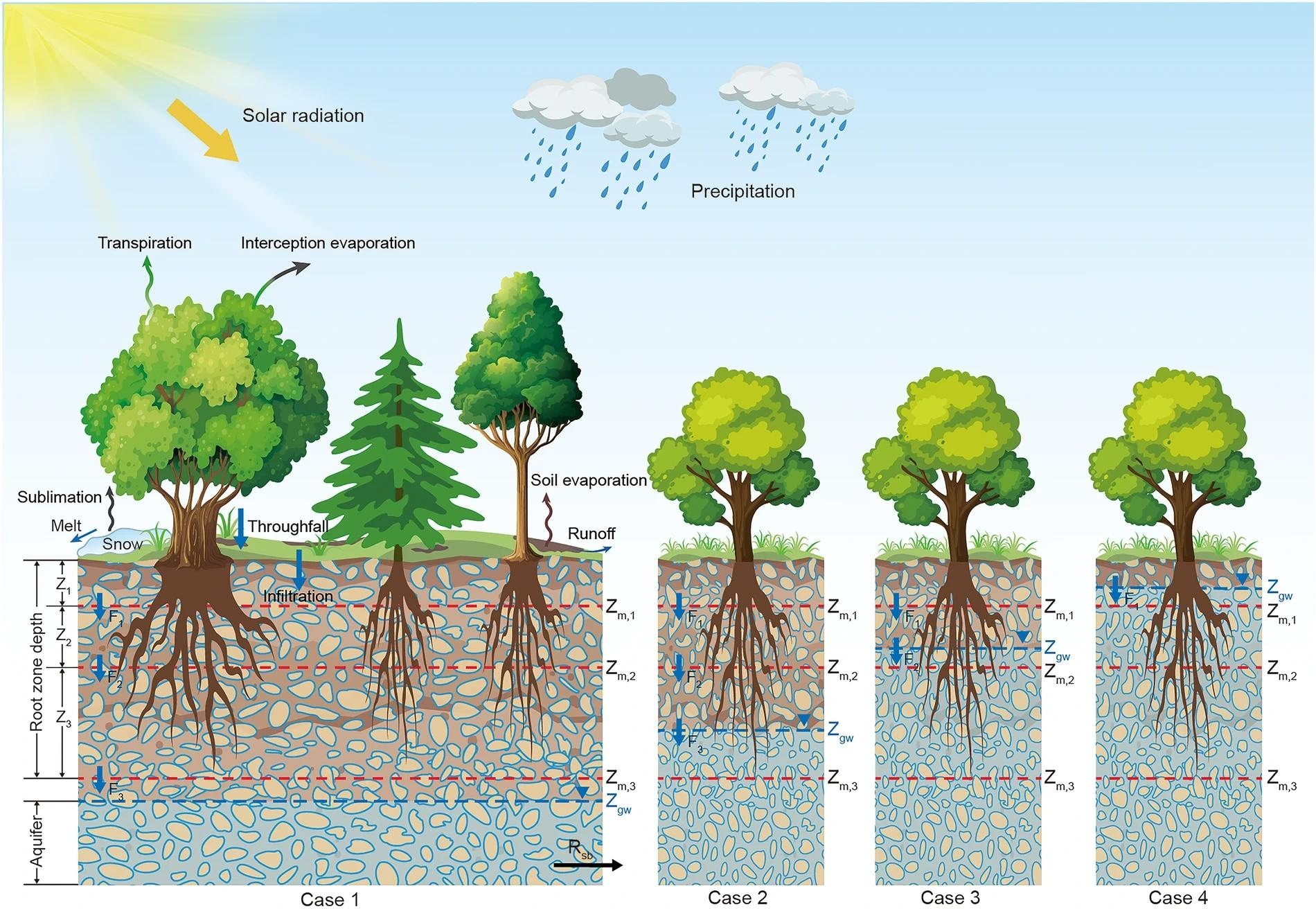In a paper published in the journal Scientific Data, researchers introduced a simple terrestrial hydrosphere model, version 2 (SiTHv2), for quantifying global evapotranspiration (ET) and soil moisture dynamics.
 The conceptual diagram of the hydrological process in the SiTHv2 model. Different cases indicate the groundwater table (zgw) dynamically related with potential root zone depth. Image Credit: https://www.nature.com/articles/s41597-024-03271-7
The conceptual diagram of the hydrological process in the SiTHv2 model. Different cases indicate the groundwater table (zgw) dynamically related with potential root zone depth. Image Credit: https://www.nature.com/articles/s41597-024-03271-7
Utilizing satellite observations and reanalysis data, SiTHv2 provided high-resolution daily estimates of ET components and three-layer soil moisture dynamics. Validation against in situ measurements confirmed its accuracy, making it valuable for water cycle dynamics, drought assessment, and ecosystem health studies.
Background
Past work has highlighted the role of water and energy exchanges between land and atmosphere, particularly through ET, in shaping climate dynamics. Accurate ET and soil moisture estimation is crucial for understanding global energy and water cycles. Previous models, like SiTH, have shown promise in integrating eco-hydrological processes. However, limitations still need to be made in capturing global-scale effects such as groundwater dynamics and root distribution.
Advancing Terrestrial Hydrology
Various remote sensing datasets were employed to drive the SiTHv2 model, including leaf area index (LAI) from the European Geoland2/BioPar project version 2 (GEOV2) project, vegetation optical depth (VOD) from VODCA, and surface albedo from the GLASS product.
Hydrometeorological variables such as air temperature, air pressure, and radiation data were obtained from the multi-source weather (MSWX) and European reanalysis 5th generation (ERA5)Land datasets. Land cover dynamics were derived from the historic land dynamics assessment+ (HILDA+) product, while soil type information was sourced from the HWSD database. These datasets' spatial and temporal resolutions were standardized using resampling and interpolation techniques.
SiTHv2 estimates were validated using in situ measurements and compared against existing ET and soil moisture products. The validation included comparing latent heat flux measurements from global eddy covariance stations and water-balanced ET calculations at the basin scale.
Additionally, soil moisture estimates were validated against in-situ measurements and compared with other satellite-derived products such as soil moisture ocean salinity (SMOS) at the Barcelona Expert Centre (BEC); soil moisture active passive (SMAP) level-3 products, as well as C-band (6.9 and 7.3 GHz) products from the advanced scatterometer (ASCAT) and the advanced microwave scanning radiometer 2 (AMSR2).
The SiTHv2 model integrates eco-hydrological processes to simulate water and energy exchanges within the groundwater-soil-plant-atmosphere continuum. It calculates total ET as the sum of soil evaporation, plant transpiration, and canopy interception evaporation. The model accounts for various constraints on ET, including soil moisture, vegetation water content, and temperature. The critical threshold of soil moisture for plant water stress is dynamically determined based on plant traits and environmental conditions.
The SiTHv2 model was applied globally at a spatial resolution of 0.1° to estimate daily terrestrial ET and soil moisture dynamics across three soil layers from 1982 to 2020. Parallel computation was utilized to enhance computational efficiency, and a 100-year spin-up period was employed to achieve equilibrium states for intermediate variables. The resulting dataset provides seamless global estimates of total terrestrial ET, plant transpiration, soil evaporation, canopy intercepted evaporation, and soil moisture at daily, monthly, and yearly temporal resolutions.
ET Validation Results
At the site scale, the SiTHv2 model's estimates of ET were validated using observed latent heat flux (LE) data from the FLUXNET - phase 3 dataset of meteorological and flux measurements (FLUXNET2015) dataset. The analysts converted the in-situ latent heat flux (LE) measurements into ET values, enabling comparisons across different plant functional types (PFTs).
The results indicated strong agreement between SiTHv2-derived ET estimates and flux observations, with correlation coefficients (R) exceeding 0.76 across various PFTs. Notably, the SiTHv2 model demonstrated high accuracy in grasslands, wetlands, and deciduous broadleaf forests. Additionally, comparisons at the basin level showed significant agreement between SiTHv2-derived ET and independent water balance results across 49 major global basins.
Comparison with other global ET products, such as the global land evaporation Amsterdam model (GLEAM) and the calibration-free complementary relationship (CR) models, highlighted the accuracy and reliability of SiTHv2-derived ET estimates. While SiTHv2 demonstrated comparable performance in linear regression slopes, it showed superior intercepts, indicating closer estimates to independent water balance-derived ET in basins with low ET volumes. Moreover, SiTHv2's annual variation of global terrestrial ET fell within the interquartile range of CMIP6 results, showcasing its consistency with other mainstream global ET products.
The SiTHv2 model's estimates of soil moisture (SWC) were validated using in-situ observations at 12 sites globally. These comparisons indicated that the SiTHv2 model effectively captured dynamic changes in SWC across different sites, with correlation coefficients averaging 0.75 and relatively small root mean square error (RMSE) values. Furthermore, comparisons with data-driven and satellite-based SWC products demonstrated strong spatial agreement and reliability of SiTHv2-derived SWC estimates globally.
Conclusion
To sum up, the development of SiTHv2 represented a significant leap in accurately quantifying global terrestrial ET and soil moisture dynamics. Through satellite observations and hydrometeorological data integration, SiTHv2 provided a seamless dataset of daily ET estimates and soil moisture dynamics at high spatial resolution.
Validation exercises confirmed its robust performance, making it valuable for water budget assessments and vegetation response studies. With its broad applicability, SiTHv2 contributed to the understanding of the global water cycle and supported informed decision-making for sustainable water resource management.